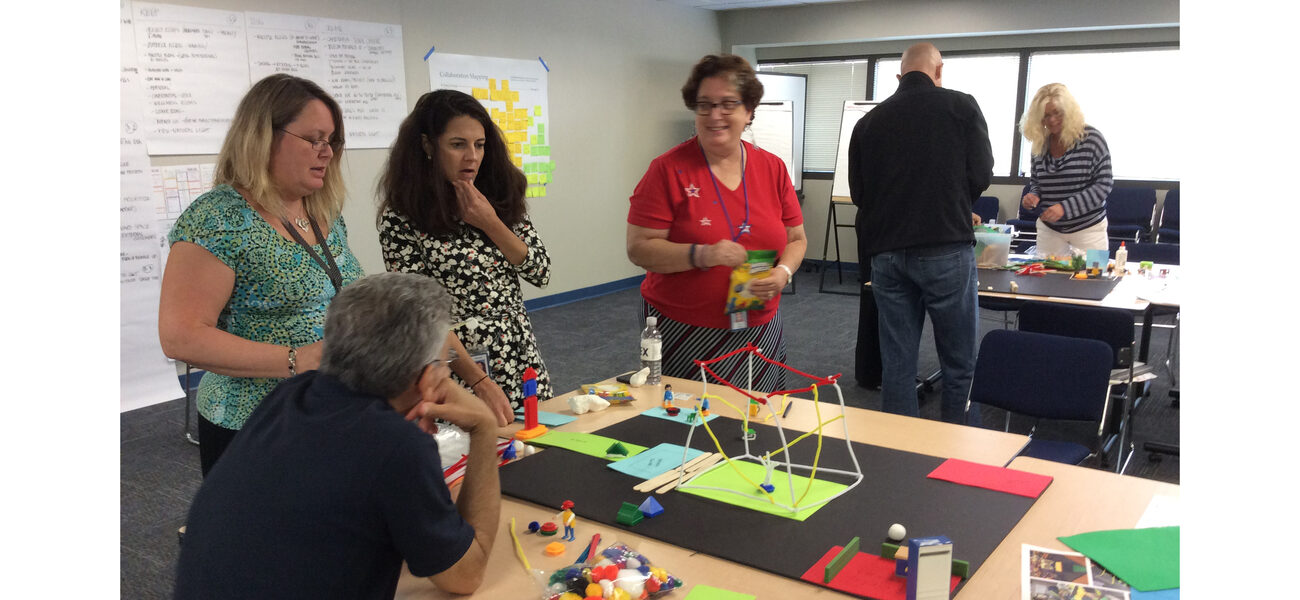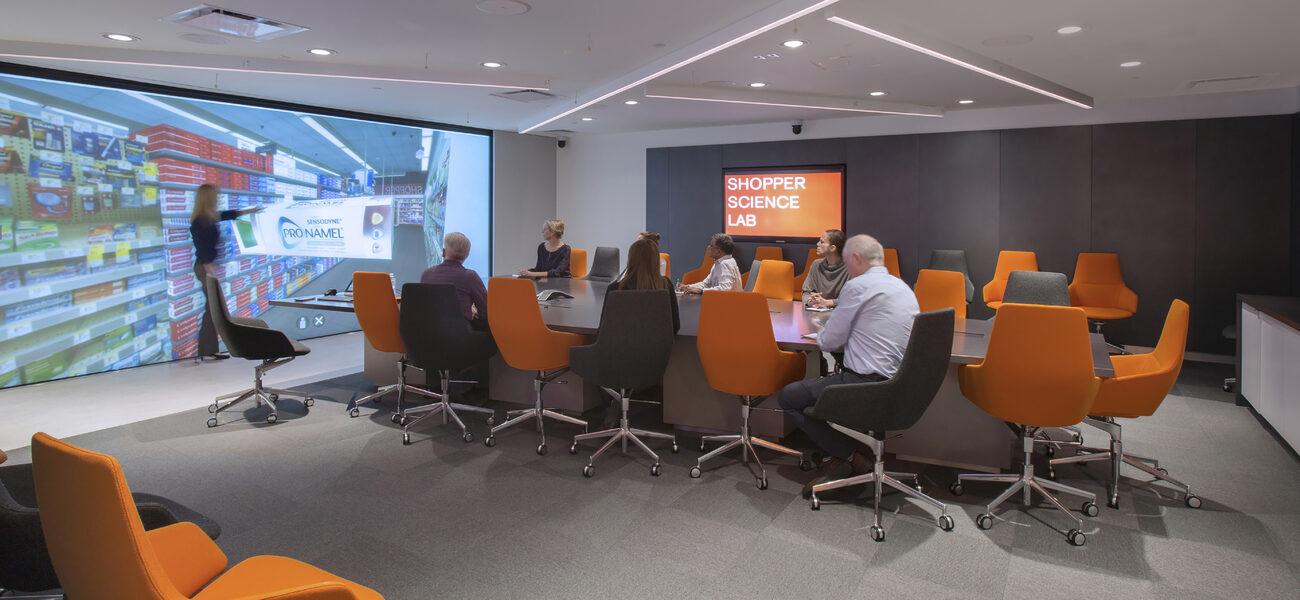Innovation has become the lifeblood of corporate and institutional longevity. Whether a disruptive breakthrough or a line extension, more often than not it is the result of an idea that follows an obscure networked path before evolving into a viable new product or business model. Facilities have a huge impact on the pace and outcome of the innovation process. A variety of spaces, each tailored to foster a specific type of activity, is essential to the innovative workplace. “At the end of the day, innovation is all about providing the right spaces to enable people to use their creative brains in the best manner to come up with new ideas,” says John Campbell, president and lead workplace strategist at the architecture firm FCA. “The design must address the human behaviors that drive the process.”
The Seven Steps
The starting point is a solid understanding of the innovation process itself.
Campbell breaks down the innovation process into a sequence of seven steps: preparation, exploration, incubation, insight, prototype and trial, planning and execution, and reflection and evaluation. While the process is linear, it diverges into an iterative loop post-prototyping, when a team will often double back (even multiple times) for further exploration and incubation before continuing through the cycle for the final steps. Each of the steps has its own particular space needs, a combination taken from four different types: individual, team, disengage/regenerate, and maker/prototype.
Campbell outlines the activities of each step as follows:
Preparation: This is a two-part phase, first defining the problem, understanding the task, and gauging and challenging its scope; followed by determining the bigger-picture issue, “the underlying problem we are trying to resolve,” according to Campbell. The step requires three types of space: individual, team, and regenerative.
Exploration: Next comes information gathering, with a search for divergent sources of inspiration. As an example of the potential for cross-pollination, Campbell cites the online financial services company Vanguard, which looked to a completely different industry—healthcare delivery—for insight into the customer experience and how to improve it. This step also calls for individual, team, and regenerative space.
Incubation: After all the input is collected, it’s time for team members to disengage, “allowing the subconscious mind to work on the issue.” Some combination of individual and regenerative space is most conducive to this activity.
Insight: At this point, the team is ready to move from tacit to explicit knowledge, determining whether the new idea is sufficiently worthwhile to take to the next phase. This is done in both individual and team spaces.
Prototype & Trial: The concept is brought to life and put through a series of tests and trials to determine its viability. The results will either trigger the iteration loop, for more exploration and incubation, or send it on to the insight phase again. Along with individual and team spaces, maker/prototype space is necessary.
Planning & Execution: The penultimate step of beta testing for market, planning, and execution takes place in individual, team, and maker/prototype spaces.
Reflection & Evaluation: The impact of the idea is tested against intention, and analysis reveals lessons learned. The same combination of spaces as the first two steps—individual, team, and disengage/regenerative—comes into play.
Characteristics of the Space Types
Campbell emphasizes that while each space type has certain characteristics, there are no hard and fast rules for sizes, ratios, and specific configurations. Rather, the overarching goal is to provide choices, and every company or institution will have a different approach.
“As a design team, when we go into a project, we try to understand its objectives. Once defined, we think about the behaviors we are trying to promote to achieve innovation, and then we create an array of different work settings.”
Individual spaces no longer automatically equate to one workstation or office per person. In an era when the typical building now provides seats for only 70 to 80 percent of its occupants, the notion of individual space has morphed significantly, from a stationary home base to a place that enables heads-down concentration. Sometimes the space is a desk, but it could also be a library or a quiet room, notes Campbell.
An interesting consequence of this shift is reflected in corporate spending. “In the past, the bulk of the furniture budget was for workstations. Miscellaneous comfortable seating and lounge and conference room furniture accounted for just a small part, but now they represent about half of overall spending.”
Whether for group work or formal meetings, team space provides the backdrop for active engagement. It can take several forms, from variously sized conference rooms to a dedicated war room that’s assigned to a particular team for the duration of a specific project. Like break-out rooms adjacent to a lecture hall, the availability of some social space outside the team room allows people to hang out nearby, discussing meeting content and potentially starting a fresh cycle of ideas and thought processes.
As innovation increasingly turns into a collaborative process, the copious information flow becomes “more than one person can typically handle,” says Campbell. This is when people need to disengage to free their subconscious brain to focus on the problem.
To allow for individual preference, various kinds of regenerative settings should be available. For some it will be a quiet room in which to meditate. For others, it will be a trip to the coffee bar for a snack. Still others will want to get out for a walk.
“Most really great ideas don’t often happen at work,” he says. “For me, most of my more intriguing thoughts come together when I’m biking along the river. People need the freedom to get out a bit. An innovative company understands that it’s about building trust and creating the right environment and cultural values that allow people to perform at their best.”
He also advises, “The best thing any designer can do in any work space is to provide natural light and exterior views. The whole body responds positively to that.”
Maker/prototype space can range from a “skunk works” or assembly rooms, with all kinds of tools and equipment, to small research labs with moveable fume hoods, to a digital replica of a retail store interior, depending on the nature of the business and the kind of innovations it is pursuing.
“It’s about providing an array of different settings to match individual behaviors,” says Campbell. “As we work with a client to understand who they are, we start to create a matrix of space types, vary the ratios and size of team and meeting rooms, the relationship between labs and write-up space, and so on.”
Culture Rules!
Providing the appropriate combination of spaces to support the innovation process is critical, but Campbell points out that there is another element that reigns supreme: culture.
“Culture is king, and queen, because it sets the tone and the boundaries.”
Workplace governance has to reflect the culture as described in the corporate or institutional mission and values—“who you are and what you want to be.” Those tenets must be embedded in workplace practices and “lived” authentically. Mere lip service isn’t adequate. “People know when it’s just a sham,” he remarks.
In many ways, it comes down to employee characteristics. In Campbell’s experience, organizations in search of innovation will simply not hire a person if the cultural fit isn’t right. While the requirements of leadership roles are fairly straightforward, he is seeing the rise of two new employee categories in the new workplace modes—the facilitator and the community manager, also referred to as curator or concierge.
“When leading groups through innovation, you need someone to keep things on track and move them along, to avoid going down a rabbit hole,” he explains. “This is the facilitator, almost like an agent provocateur.”
Migrating from the co-working model, the community manager slot is a hybrid of facilities and HR functions, focusing more on personal connections—touchpoints—and interaction. The primary charge is to bring disparate group of people together. This can be accomplished across a broad spectrum of activities, whether curating events like speakers and happy hours to promote engagement, or smoothing the onboarding process and providing a direct link to business services.
“The interaction element in an agile workplace is of major importance,” says Campbell. “The concierge makes sure people settle in comfortably, serving as the touchpoint to resolve any IT problems or desk issues. People work so many hours in these spaces, so having someone to arrange all the other things they need in their life is becoming a huge role. This is a whole new position that is coming into its own, in business and academia.”
Successful Innovation Spaces
Campbell cites several examples of workplaces that blend the spaces and culture necessary for innovation to thrive. At the design and consulting firm IDEO, known for its innovation, team spaces prevail. When a new project is commissioned, the assigned design team is embedded in a dedicated but flexible “war room,” which can be configured according to the tasks at hand. White boards, projection screens, walls for sticky notes, and long tables for individual work can all be part of the furnishings. Sometimes a war room can be set up in an old warehouse. The appearance of the space is not nearly as important as its role as a comfortable backdrop for creativity.
“It is not about beautiful space; being messy is good,” says Campbell. “The point is to generate new ideas and accommodate different stimuli coming together.”
At the Stanford d.school, where students learn how to tap their own creativity by tackling assigned problems in multidisciplinary groups, there is little space defined by permanent walls. Instead, moveable partitions can be rearranged to cordon off specific work areas. “It has flexible equipment, team space, presentation space, and small escape huddle rooms in which people can create their own environments,” says Campbell. Because there are no rules, he continues, “people have to learn their own space boundaries, so it becomes about protocol.”
The Innovation Center at the New School’s Parsons School of Design reflects the changing higher education landscape, where a teacher’s role is more team coach than lecturer. As the project architect, Campbell’s firm downsized the classrooms in order to create a more communal, town-hall-type multiuse space within the allotted square footage. Spaces are segmented into six categories: basic, used by many, used by few, doing/making/messy, highly specialized, and sharing/showing.
GlaxoSmithKline’s consumer health division created a very different kind of innovation space, one devoted to building relationships with its drugstore partners. The Shopper Science Lab focuses on new ways to innovate, package, and present drugs in the retail environment. A highlight of the space is a room with a giant (30-by-9-foot) “iPad” interactive screen that displays merchandise in a digital store to test new concepts and ideas. The facility includes a small lab to produce limited quantities of product, which consumers can then test on site, in a process that accelerates time to market. There is also some individual “recharge and get-away” space, set apart from other activity.
The New York Hotel Trades Council Brooklyn Health Center, which opened in January 2018, serves as another example that innovation space can apply not just to the production of products but also to new business models. Inspired by the simplicity of a hotel chain’s mobile check-in process, the building streamlines healthcare delivery through the use of technology to create a one-stop-shop for time-pressed council members and their families. Waiting rooms have been eliminated; on arrival, patients are given an RFID tag and proceed straight into an exam room, after which they can collect their prescriptions at the on-site pharmacy. “The architectural space had to create a setting to let this flow work,” comments Campbell. Three months into occupancy, doctors reported being less stressed while able to see 30 percent more patients, a welcome efficiency promising “huge financial returns for national health.”
By Nicole Zaro Stahl
| Organization | Project Role |
|---|---|
|
FCA
|
Architect
|

